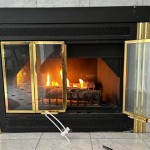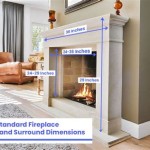Cleaning The Inside Of A Fireplace
A fireplace, while offering warmth and ambiance, requires regular maintenance to ensure safe and efficient operation. One of the most crucial aspects of fireplace maintenance is thoroughly cleaning its interior. Accumulated soot, ash, and creosote not only detract from the fireplace's aesthetic appeal but also pose significant fire hazards. This article outlines the necessary steps and considerations for effectively cleaning the inside of a fireplace.
Safety Preparations and Required Materials
Prior to commencing any cleaning activity, safety precautions must be implemented. Allowing the fireplace to cool completely, preferably for at least 24 hours after the last fire, is paramount. This eliminates the risk of burns. Furthermore, wearing appropriate protective gear is essential. This includes safety glasses to shield the eyes from dust and debris, a dust mask or respirator to prevent inhalation of particulate matter, and durable gloves to protect the hands from grime and potential irritants.
Gathering the necessary cleaning materials is the next crucial step. A stiff-bristled brush, ideally one specifically designed for fireplaces, is indispensable for dislodging soot and creosote from the firebox walls. A shop vacuum, featuring a HEPA filter, is recommended for efficiently removing loose debris and fine particles. Standard household vacuums are often ill-equipped to handle the volume of ash and the fineness of the particles, potentially damaging the motor or releasing dust back into the air. A metal shovel or sturdy scoop is needed for removing larger accumulations of ash from the firebox floor. Additionally, a spray bottle filled with a fireplace cleaner or a solution of mild detergent and water will aid in loosening stubborn stains. Finally, drop cloths or old sheets should be used to protect the surrounding area from dust and spills.
Step-by-Step Cleaning Process
The initial step involves preparing the surrounding area. Spreading drop cloths or old sheets around the fireplace opening protects the flooring and nearby furniture from ash, soot, and cleaning solution. Sealing off the fireplace opening with plastic sheeting, secured with painter's tape, further minimizes the spread of dust into the room. Ensuring adequate ventilation by opening windows and doors is also advisable, particularly when using cleaning solutions.
Next, the process of removing ash and debris commences. Using the metal shovel or scoop, carefully remove the bulk of the ash from the firebox floor and deposit it into a metal container. Avoid using plastic containers, as embers can remain hot for extended periods. Once the majority of the ash is removed, utilize the shop vacuum with a HEPA filter to thoroughly vacuum the firebox floor, walls, and any crevices where ash may have accumulated. Pay particular attention to the area around the damper, ensuring it is free from debris.
With the loose debris removed, the focus shifts to cleaning the firebox walls. Apply the fireplace cleaner or the mild detergent solution to the walls, allowing it to dwell for a few minutes to loosen stubborn stains. Using the stiff-bristled brush, scrub the walls thoroughly, paying particular attention to areas with heavy creosote buildup. Applying firm, even pressure is essential to effectively dislodge the soot and creosote without damaging the firebox material. After scrubbing, wipe down the walls with a damp cloth to remove the cleaning solution and any remaining residue. If necessary, repeat the cleaning process for particularly stubborn stains.
The fireplace grate, if present, should also be cleaned. Remove the grate from the firebox and scrub it with the stiff-bristled brush to remove any accumulated ash and debris. If the grate is heavily soiled, it can be soaked in a solution of soapy water before scrubbing. Rinse the grate thoroughly with clean water and allow it to dry completely before returning it to the firebox.
Addressing Creosote Buildup and Professional Inspection
Creosote, a highly flammable byproduct of burning wood, poses a significant fire hazard when it accumulates in the fireplace and chimney. It is imperative to manage creosote buildup effectively. While routine cleaning can remove surface creosote, professional chimney sweeping is essential for removing hardened creosote from the chimney flue. A certified chimney sweep possesses the specialized tools and expertise to safely and effectively remove creosote, reducing the risk of chimney fires.
The frequency of professional chimney sweeping depends on the frequency of fireplace use and the type of wood burned. As a general guideline, an annual inspection by a certified chimney sweep is recommended. If the fireplace is used frequently, or if softwoods such as pine are burned, more frequent cleaning may be necessary. The chimney sweep can assess the condition of the chimney and fireplace, identify any potential hazards, and provide recommendations for necessary repairs or maintenance.
During the inspection, the chimney sweep will examine the chimney flue for cracks, obstructions, and signs of water damage. Any damage to the chimney structure can compromise its integrity and increase the risk of fire or carbon monoxide poisoning. Early detection and repair of chimney problems are crucial for maintaining a safe and efficient fireplace.
Beyond creosote removal, professional inspection also allows for assessment of the fireplace damper's functionality. A properly functioning damper is essential for regulating airflow and preventing heat loss when the fireplace is not in use. A damaged or malfunctioning damper should be repaired or replaced to ensure efficient fireplace operation.
Regular cleaning of the fireplace interior, coupled with professional chimney sweeping and inspections, contributes significantly to the safe and efficient operation of the fireplace. Adhering to a consistent maintenance schedule minimizes the risk of fire hazards, maximizes heating efficiency, and extends the lifespan of the fireplace system.

How To Clean A Fireplace Diy Basics

How To Clean Brick Fireplaces Mantels Hearths And More My Space

Fireplace Cleaning Tutorial Kippi At Home

Cleaning Inside A White Fireplace Domestically Blissful

Cleaning The Inside Of Gas Fireplace Glass Thrifty Decor Diy And Organizing

How To Clean Fireplace Bricks 9 Steps With S Wikihow

How To Clean A Gas Fireplace The Proper Way

Cleaning Inside A White Fireplace Domestically Blissful

Stone Fireplace Makeover Part 1 Plans Prep Organized Ish

Why Is It Important To Get My Gas Fireplace Logs Clean Regularly
Related Posts








